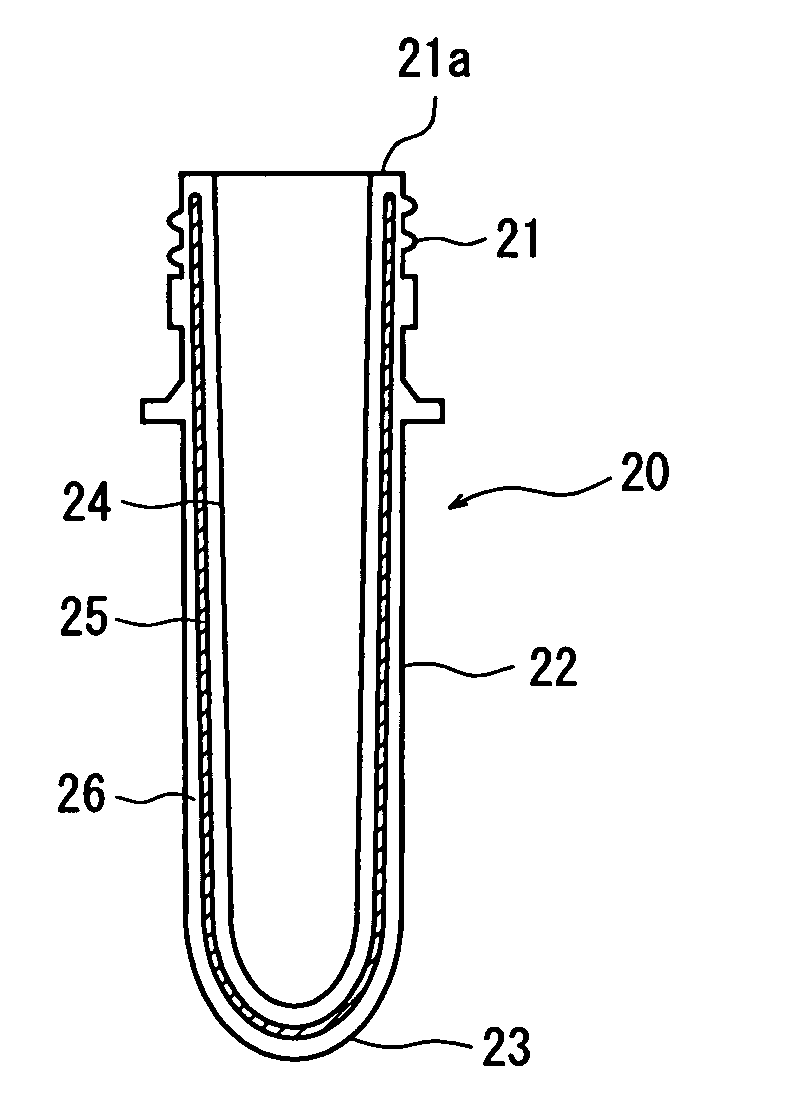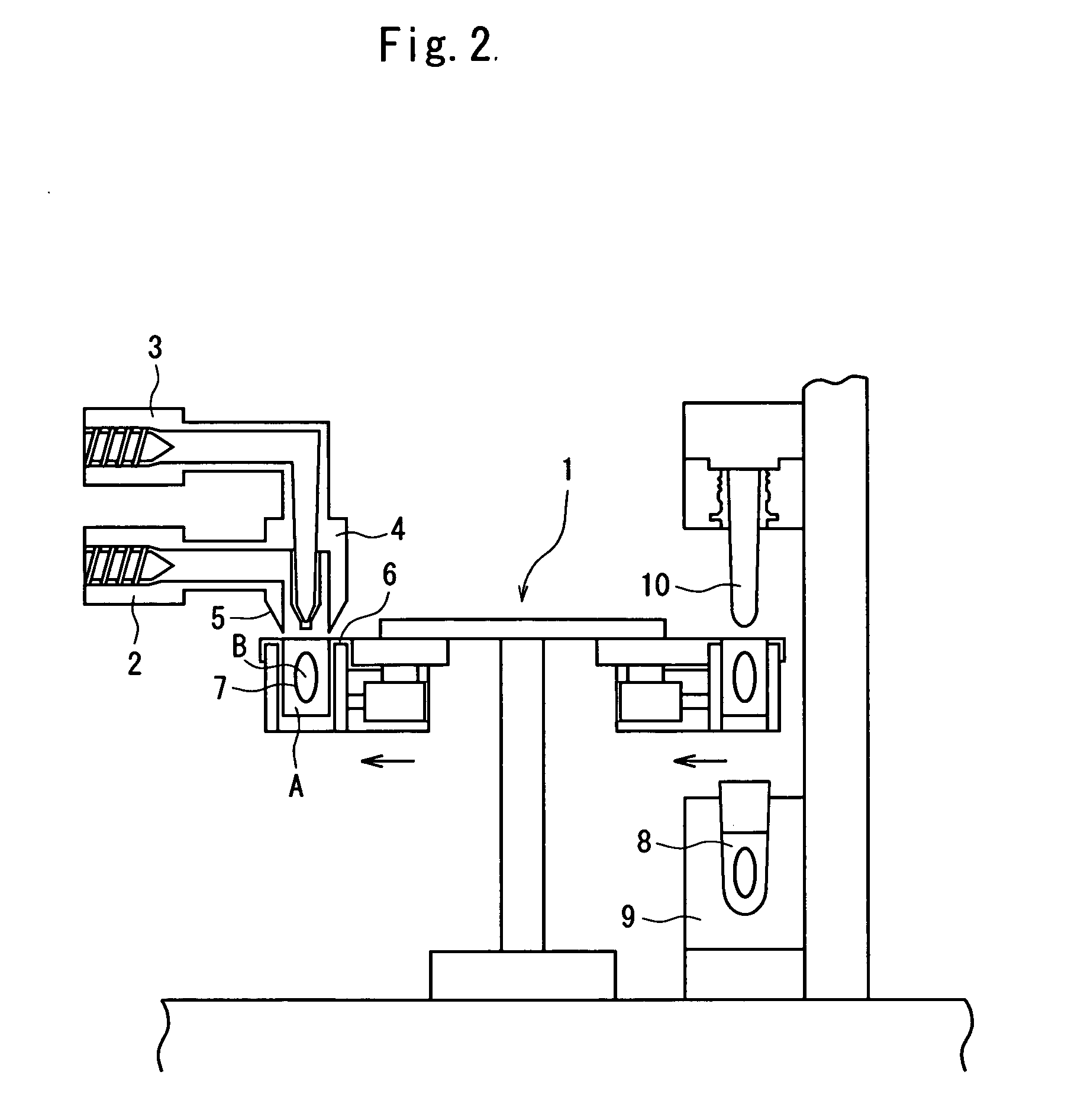Preform, process for producing the same, and biaxially stretched container obtained from the preform
a preform and multi-layer technology, applied in the direction of synthetic resin layered products, transportation and packaging, other domestic articles, etc., can solve the problems of deteriorating the flavor-retaining property of the bottle, difficult to obtain satisfactory mechanical strength, etc., to reduce mechanical strength, reduce flavor retentivity, and large draw-down tendency
- Summary
- Abstract
- Description
- Claims
- Application Information
AI Technical Summary
Benefits of technology
Problems solved by technology
Method used
Image
Examples
example 1
[0085] A polyethylene terephthalate resin (5015W manufactured by Shinkogosen Co., containing 98.0 mol % of ethylene terephthalate units, melting point of 244° C., inherent viscosity of 0.83) was fed into the hopper of an extruder, extruded under the conditions of a temperature of 270° C. at the die portion, resin pressure of 70 kgf / cm2 and an inherent viscosity of the molten polyester resin at the time of melt extrusion of 0.78 dL / g, and was cut into a molten resin mass.
[0086] The molten resin mass was set into a compression metal mold maintained at 20° C. and was compression-formed under a condition of the mold-tightening pressure of 100 kgf / cm2 to form a single-layer preform.
[0087] The obtained preform was heated at a drawing temperature of 110° C. and was biaxially draw blow-formed in a metal mold maintained at 25° C. to obtain a bottle having a weight of 25 g and a volume of 530 ml.
[0088] The preform that was formed was measured for its DSC, and the bottle was measured for it...
example 2
[0089] A preform and a bottle were formed in the same manner as in Example 1 but extruding, as the polyester resin, a polyethylene terephthalate resin (J125T manufactured by Mitsui Kagaku Co., containing 100 mol % of ethylene terephthalate units, melting point of 254° C., inherent viscosity of 0.75 dL / g) under such a condition that the inherent viscosity of the molten polyester resin at the time of melt extrusion was 0.72 dL / g, setting the temperature of the metal mold in the biaxial draw blow-forming to be 150° C. and effecting the thermal fixing in the metal mold, and were evaluated in the same manner as in Example 1.
example 3
[0090] A polyethylene terephthalate resin (5015W manufactured by Shinkogosen Co., containing 98.0 mol % of ethylene terephthalate units, melting point of 244° C., inherent viscosity of 0.83) was fed into an extruder for forming inner and outer layers, and a recycled polyester resin (flakes manufactured by Yono PET Bottle Recycle Co.) was fed into a biaxial extruder with a vent for forming an intermediate layer. The resins were co-extruded in a manner that the recycled polyester resin was sealed with the polyethylene terephthalate resin under the conditions of a temperature of 270° C. at the die head, resin pressure of 70 kgf / cm2 and an inherent viscosity of the molten polyester resin at the time of melt extrusion of 0.74 dL / g, and were cut into a molten resin mass.
[0091] The molten resin mass was set into a compression metal mold maintained at 20° C. and was multi-layer compression-formed under a condition of the mold-tightening pressure of 100 kgf / cm2 to form a two-kind-three-laye...
PUM
| Property | Measurement | Unit |
|---|---|---|
| Temperature | aaaaa | aaaaa |
| Time | aaaaa | aaaaa |
| Fraction | aaaaa | aaaaa |
Abstract
Description
Claims
Application Information
 Login to View More
Login to View More - R&D
- Intellectual Property
- Life Sciences
- Materials
- Tech Scout
- Unparalleled Data Quality
- Higher Quality Content
- 60% Fewer Hallucinations
Browse by: Latest US Patents, China's latest patents, Technical Efficacy Thesaurus, Application Domain, Technology Topic, Popular Technical Reports.
© 2025 PatSnap. All rights reserved.Legal|Privacy policy|Modern Slavery Act Transparency Statement|Sitemap|About US| Contact US: help@patsnap.com



